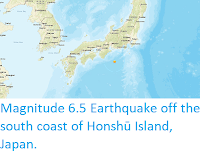Three people have died and more than fifty more have been injured after Tropical Storm Krosa made landfall on Honshū Islands, Japan, close to Kure City in Hiroshima Prefecture, at about 3.00 pm local time on Thursday 15 August 2019. Neneko Mori, 11, died after being swept out to sea with her sister near Shimoda City; her body was later recovered at Shizuoka on the other side of Suruga Bay, her sister was able to swim back to shore alive. In Hyogo Prefecture fisherman Noriyuki Kumabuchi, 71, died after being swept into a river, and in in Onomichi in Hiroshima Prefecture an 82-year-old man died after being swept into the sea while tyong up a boat.
Large waves associated with Tropical Storm Krosa at Shirahama in Wakayama Prefecture. Tatsuya Onishi/Mainichi.
Wakayama Prefecture
Shirahama
Shirahama
The storm brought with it very high rainfall, with 869.5 mm of rain recorded in three hours at Yanase in Kochi Prefecture. This triggered a number of landslides, which are not thought to have caused any injuries but which have blocked roads in some areas. Landslides are a common problem after severe weather events, as excess pore water pressure can overcome cohesion in soil and sediments, allowing them to flow like liquids. Approximately 90% of all landslides are caused by heavy rainfall. Other transport networks have also been disrupted, with numerous flights and rail services cancelled due to the storm.
Tropical storms are caused by the warming effect of the Sun over
tropical seas. As the air warms it expands, causing a drop in air
pressure, and rises, causing air from outside the area to rush in to
replace it. If this happens over a sufficiently wide area then the
inrushing winds will be affected by centrifugal forces caused by the
Earth's rotation (the Coriolis effect). This means that winds will be
deflected clockwise in the northern hemisphere and anti-clockwise in the
southern hemisphere, eventually creating a large, rotating Tropical
Storm. They have different names in different parts of the world, with
those in the northwest Pacific being referred to as typhoons.
A tree uprooted by Tropical Storm Kroda in Hiroshima. Kyodo News.
Despite the obvious danger of winds of this speed, which can physically
blow people, and other large objects, away as well as damaging buildings
and uprooting trees, the real danger from these storms comes from the
flooding they bring. Each drop millibar drop in air-pressure leads to an
approximate 1 cm rise in sea level, with big tropical storms capable of
causing a storm surge of several meters. This is always accompanied by
heavy rainfall, since warm air over the ocean leads to evaporation of
sea water, which is then carried with the storm. These combined often
lead to catastrophic flooding in areas hit by tropical storms.
See also...
Follow Sciency Thoughts on Facebook.









